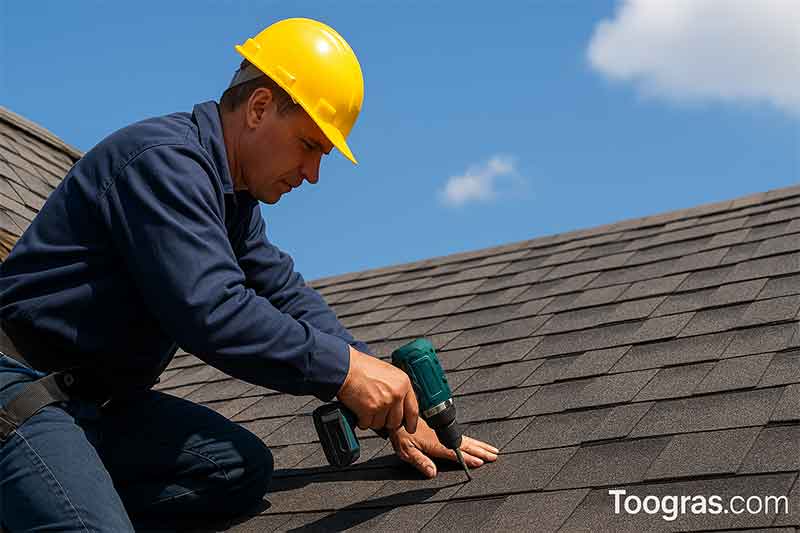Understanding Your Roof Payment Schedule
If you’ve ever replaced or repaired a roof, you already know it’s not a cheap project. Roofs are one of the biggest investments for any homeowner. And like any big purchase, managing payments wisely can save you a lot of financial stress. That’s where a roof payment schedule comes in.
In this guide, we’ll break down what a roof payment schedule is, how it works, what to look out for, and how to protect yourself financially. Whether you’re planning a full roof replacement or just a repair, understanding your payment plan can make the process smoother and safer.
What Is a Roof Payment Schedule?
A roof payment schedule is basically a timeline that outlines when and how much you’ll pay your roofing contractor during the project.
Instead of paying the entire amount upfront (which is risky), payments are divided into parts — often tied to certain milestones, like signing the contract, delivery of materials, or completion of work.
Think of it like a roadmap for your money. It keeps both you and the contractor accountable.
Why Payment Schedules Matter
You might be wondering: Why can’t I just pay when it’s done?
Well, roofing jobs require materials, labor, and sometimes permits — all of which cost money upfront. A fair payment schedule ensures the roofer can cover those expenses without putting the entire burden on you.
At the same time, it protects you from overpaying before the job is finished. It’s all about balance and trust.
Typical Roof Payment Schedule Breakdown
Every roofing company might structure their schedule differently, but most follow a similar pattern. Here’s what a standard one might look like:
1. Deposit or Down Payment (10%–30%)
This first payment usually happens when you sign the contract. It shows commitment and helps the contractor purchase materials.
Tip: Avoid paying more than one-third upfront. If a roofer asks for 50% or more, that’s a red flag.
2. Material Delivery or Project Start (30%–40%)
Once materials are delivered to your property, another payment is typically due. This step shows progress — your roofer has already spent money on supplies and labor is about to begin.
3. Midpoint Payment (20%–30%)
If your project takes more than a few days, there might be a payment scheduled halfway through. This helps keep cash flow stable for the contractor while work continues.
4. Final Payment (10%–20%)
The last payment is made after the job is done and you’re satisfied with the results.
Never pay the full balance until:
- The roof passes inspection.
- All materials are removed from your property.
- You have received a warranty and proof of completion.
How to Protect Yourself When Agreeing to a Roof Payment Schedule
When it comes to construction or roofing jobs, scams do happen. So it’s smart to take precautions before you sign anything.
Here’s what you should do:
1. Get Everything in Writing
A verbal promise means nothing in the roofing business. Always ask for a written contract that includes the payment schedule, total cost, project timeline, and warranty details.
2. Verify the Contractor’s License and Insurance
Make sure the roofer is licensed and insured in your state. You can check this easily on your local licensing board’s website.
If something goes wrong — like property damage or worker injury — proper insurance will protect you.
3. Avoid Full Payment Upfront
Reputable contractors never demand full payment before work begins. If someone insists, walk away.
4. Use Traceable Payment Methods
Avoid paying in cash. Use checks, credit cards, or bank transfers so you have a record of all transactions.
5. Ask About Financing Options
Some roofing companies offer payment plans or work with financing partners. If you can’t pay everything at once, this can be a huge help.
You can read more about flexible payment options in this article about dealership payment plans for repairs. The concept works similarly for roofing projects.
Common Roof Payment Schedule Terms Explained
Let’s go over a few terms you might see in your contract:
- Draw Schedule – The agreed plan showing when payments are due.
- Retention – A small amount held until the job is completed to your satisfaction.
- Progress Payment – Payments made after certain stages or milestones.
- Change Order – A written agreement for any project changes that affect cost or schedule.
Understanding these terms can help you avoid confusion later.
Factors That Affect Your Roof Payment Schedule
Every project is unique, but these factors often determine how your schedule is set up:
1. Roof Size and Material
A small asphalt roof will obviously cost less than a large slate or metal one. The bigger or more complex your roof, the more payments may be spread out.
2. Contractor Policies
Some contractors stick to standard schedules, while others are flexible. Don’t hesitate to negotiate if you prefer smaller installments.
3. Your Credit or Financing Plan
If you’re using a home improvement loan or roof financing plan, the lender might control how funds are released.
4. Local Laws and Permits
Some states limit how much a contractor can charge upfront. For instance, California caps deposits at 10% or $1,000 (whichever is less).
Red Flags in a Roof Payment Schedule
Sadly, not all contractors are honest. Here are signs something might be off:
- The roofer demands full payment before work starts.
- The schedule feels unbalanced, with too much money due early.
- There’s no written agreement.
- The contractor pressures you to pay in cash.
- They avoid giving clear answers about insurance or licenses.
If you spot any of these warning signs, take a step back. Do more research, check reviews, and maybe look for another company.
Negotiating a Fair Roof Payment Schedule
You don’t have to accept whatever the contractor offers. Here’s how to negotiate smartly:
- Ask questions about each payment phase.
- Request smaller installments if the amounts seem too high.
- Tie payments to milestones, not just dates.
- Hold at least 10%–20% until after inspection.
Most reputable contractors will agree to these reasonable terms. After all, it’s about trust and professionalism on both sides.
Roof Financing and Payment Plan Options
If paying out of pocket isn’t possible, you’re not alone. Roofs are expensive, and many homeowners choose financing.
Here are a few popular options:
1. Roofing Company Financing
Many roofing companies offer in-house payment plans or partner with lenders. Some even advertise “no payments for 90 days” promotions — similar to this guide on deferred payment plans.
These plans usually require credit approval, but they’re convenient because the roofer handles everything.
2. Home Equity Loan or Line of Credit (HELOC)
If you have equity in your home, this can be one of the lowest-interest options. Just be sure you’re comfortable using your home as collateral.
3. Personal Loans
Quick and straightforward, personal loans are great if you want fixed payments and fast approval.
4. Insurance Claims
If your roof was damaged by storms or hail, your homeowner’s insurance may cover part or all of it. Just make sure to confirm coverage before work begins.
For more on what happens when claims don’t pay out, read Claim Closed Without Payment.
The Importance of Final Inspection Before Final Payment
Never hand over that last check until the job is completely finished. Walk around your property, inspect the roof, and ensure:
- Shingles or tiles are properly installed.
- No debris or nails are left behind.
- Gutters and vents are clear.
- You’ve received your warranty and lien release.
If something feels off, talk to your contractor right away.
Bonus Tip: Keep a Paper Trail
Keep every document — contracts, receipts, warranties, and even texts or emails with your roofer. If a dispute happens later, you’ll have proof of everything.
Conclusion
A clear, fair roof payment schedule protects both your wallet and your home. It helps ensure the project runs smoothly, payments are balanced, and everyone knows what to expect.
When you understand how the schedule works, you’re in control. So before signing anything, take your time to read, ask questions, and make sure you’re comfortable with each payment stage.
Because at the end of the day, a solid roof isn’t just about shingles — it’s about peace of mind.
FAQ About Roof Payment Schedules
1. How much should I pay a roofer upfront?
Usually, 10%–30% is fair. Avoid paying the entire amount before work starts.
2. Can I negotiate my roof payment schedule?
Absolutely. Most contractors are open to reasonable requests if you communicate clearly.
3. What if the roofer asks for full payment before starting?
That’s a red flag. Look for a licensed and reputable contractor instead.
4. Do roofing companies offer payment plans?
Yes, many do. You can also use personal loans or home equity options for larger projects.
5. What happens if I miss a payment?
If you’re on a financing plan, missing a payment could affect your credit or delay work. Always contact your contractor or lender as soon as possible.
Further Reading:







